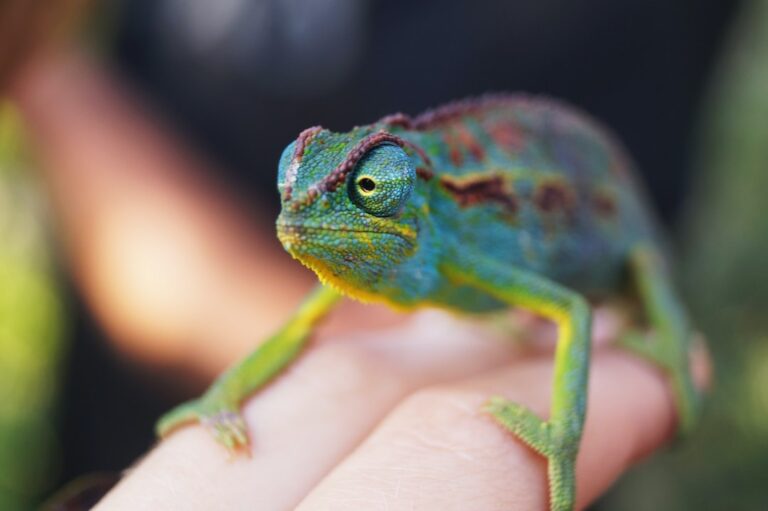How Do Chameleons Move?
Chameleons are fascinating creatures that are known for their ability to change color and their unique physical features. They belong to the family Chamaeleonidae and are found in various parts of the world, including Africa, Madagascar, and parts of Asia and Europe. Chameleons are known for their ability to blend into their surroundings by changing color, which is a result of their specialized skin cells called chromatophores. This ability helps them camouflage and avoid predators.
Table of Contents
Anatomy of Chameleons
Chameleons have several unique physical features that set them apart from other reptiles. One of the most notable features is their eyes, which are large and independently mobile. This allows them to have a 360-degree field of vision and enables them to look in different directions simultaneously. Their eyes also have a specialized structure that allows them to focus on both near and distant objects.
Another interesting feature of chameleons is their long, sticky tongue. Their tongue can be extended rapidly to catch prey, such as insects, and then retracted back into their mouth. The tongue is coated with a sticky substance that helps them capture their prey with precision.
Chameleons also have unique skin that is covered in small, bumpy scales. These scales help them blend into their surroundings by changing color. The skin also plays a role in regulating their body temperature, as chameleons are ectothermic animals.
Locomotion in Chameleons
Chameleons have a unique way of moving that sets them apart from other reptiles. They use a combination of walking, climbing, and jumping to navigate their environment. Their movement is slow and deliberate, allowing them to carefully assess their surroundings and avoid predators.
Chameleons have specialized adaptations for climbing, such as their feet and tail. They also have the ability to change their body shape to fit into tight spaces and navigate through dense vegetation. This allows them to move with ease in their arboreal habitats.
How Chameleons Walk on Branches
Chameleons have specialized adaptations that allow them to walk on branches with ease. One of these adaptations is their feet, which have specialized toes that are fused together in a unique arrangement. This allows them to grip onto branches and maintain a secure hold while moving.
In addition to their feet, chameleons also have a prehensile tail that helps them maintain balance while walking on branches. The tail acts as a counterbalance, allowing them to shift their weight and adjust their position as they move.
Chameleons’ Ability to Change Colors
One of the most fascinating aspects of chameleons is their ability to change color. This ability is not just for camouflage, but also for communication and thermoregulation. Chameleons change color by manipulating the pigments in their skin cells called chromatophores.
Chromatophores contain different pigments, such as melanin and carotenoids, which can be expanded or contracted to change the color of the skin. When a chameleon wants to blend into its surroundings, it will contract certain chromatophores to reveal darker pigments, making it appear darker or lighter depending on the background.
Chameleons can also change color as a form of communication. For example, males may change color to attract females during mating season or to establish dominance over other males. They can also change color in response to environmental factors, such as temperature or stress.
Chameleons’ Tail and Its Role in Movement
The tail of a chameleon plays an important role in its movement and balance. Chameleons have a prehensile tail, which means they can grasp objects with it. This allows them to hold onto branches and maintain balance while climbing or walking.
The tail also acts as a counterbalance, helping the chameleon shift its weight and adjust its position as it moves. This is especially important when navigating through dense vegetation or when making quick movements to catch prey.
In addition to its role in movement, the tail of a chameleon can also be used as a defensive mechanism. When threatened, a chameleon may coil its tail and use it to strike at predators, such as snakes or birds.
The Role of Muscles in Chameleons’ Movement
Chameleons have a complex muscular system that allows them to move with precision and control. They have strong muscles in their limbs, which enable them to walk, climb, and jump. These muscles work together to generate the force needed for movement.
The muscles in a chameleon’s limbs are arranged in such a way that they can move independently of each other. This allows the chameleon to have precise control over its movements and adjust its position as needed.
Chameleons also have specialized muscles in their eyes that allow them to move each eye independently. This gives them a wide field of vision and allows them to focus on different objects simultaneously.
Chameleons’ Unique Feet and Toes
Chameleons have unique feet and toes that are adapted for climbing and gripping onto branches. Their feet have specialized toes that are fused together in a unique arrangement. This allows them to grip onto branches and maintain a secure hold while moving.
The toes of a chameleon are also equipped with sharp claws that help them grip onto surfaces. These claws can be extended or retracted as needed, allowing the chameleon to adjust its grip depending on the surface it is climbing.
In addition to their toes, chameleons also have specialized pads on their feet that help them grip onto smooth surfaces. These pads are covered in tiny hairs that create friction and allow the chameleon to maintain a secure hold.
Chameleons’ Jumping Abilities
Chameleons are also capable of jumping, although they are not known for their agility in the air. They have strong hind legs that allow them to generate the force needed for a jump. When a chameleon jumps, it extends its hind legs and propels itself forward using the muscles in its legs.
Chameleons can jump both vertically and horizontally, depending on the situation. They use their tail as a counterbalance to maintain balance and control during a jump.
The mechanics of a chameleon’s jump are similar to that of other reptiles. They rely on their muscles to generate the force needed for propulsion and their limbs to control their movement in the air.
The Fascinating Movement of Chameleons
In conclusion, chameleons are fascinating creatures with unique movement abilities. Their ability to change color, walk on branches, and jump are all adaptations that have helped them survive and thrive in their arboreal habitats.
Chameleons have specialized physical features, such as their eyes, tongue, and skin, that enable them to navigate their environment with precision. Their feet and tail play important roles in their movement and balance, allowing them to walk on branches and climb with ease.
The muscles in a chameleon’s body work together to generate the force needed for movement, while their unique feet and toes provide them with the grip they need to navigate their arboreal habitats. Their ability to change color is not only for camouflage but also for communication and thermoregulation.
Overall, the movement abilities of chameleons are a testament to their incredible adaptation to their environment. They have evolved unique features and behaviors that allow them to survive and thrive in their arboreal habitats.
If you’re interested in learning more about chameleons, you might also want to check out this fascinating article on why chameleons rock back and forth. It delves into the intriguing behavior of these unique reptiles and explores the possible reasons behind this mesmerizing movement. Discover the secrets behind chameleons’ rocking motion and gain a deeper understanding of their fascinating world.







